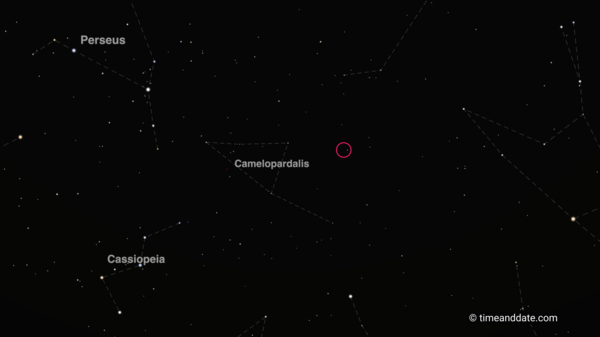Can You Find the Faint Green Comet?
Comet C/2022 E3 (ZTF) will make its closest approach to Earth on February 1. It might be possible to spot it with the naked eye.


A circle indicating the position of C/2022 E3 (ZTF) has been added to this image from our Night Sky Map, looking north from New York at 21:00 (9:00 pm) local time on February 1 (click to zoom in). A bright Moon will make comet observations more difficult.
Find the Moon, planets, and stars on our Night Sky Map
What Is the Green Comet?
C/2022 E3 (ZTF) is a green-ish comet that was discovered on March 2 last year.
It reached its closest point to the Sun on January 12. The Green Comet will be at its closest to Earth—and at its brightest in our skies—on February 1.
Comets are small bodies made of ice and dust. Their orbits around the Sun carry them from the far, outer parts of the solar system to the inner solar system, where they can become visible from Earth.
When comets are close to the Sun, they warm up. Sometimes—but not always—they develop distinctive tails of gas and dust. The head of the comet can glow green due to the presence of a chemical called diatomic carbon.
Can I See It with the Naked Eye?
The brightness of an object for observers on Earth is measured by apparent magnitude. The higher the number, the fainter the object.
The magnitude of Sirius, the brightest star, is -1.4; Polaris, the North Pole star, is 2.0. The faintest magnitude that can be seen with the naked eye in good dark-sky conditions is roughly 6.5.
At its brightest, the magnitude of C/2022 E3 (ZTF) is predicted to be about 5.0. This means it may be observable with the naked eye, in dark skies away from light pollution, around the end of January and the beginning of February.
It will not be easy to observe: at best, it will appear as a faint smudge. The beautiful images we’ll enjoy in the media—showing the comet as a bright green star with a long tail—are only possible with the right equipment and long exposures.
Where Can I See It?
Between mid-January and mid-February, the Green Comet will travel a little bit every day across the starry background of the night sky.
The best chance to see it will be when it is at its closest to Earth. Around this time, the comet will be traveling through a faint constellation of stars called Camelopardalis. A bright Waxing Gibbous Moon will make it more difficult to see the comet (although the Moon will set toward the end of the night, before the Sun rises).
In the image at the top of this page, we’ve added a red circle to our Night Sky Map for New York to indicate the position of the comet within Camelopardalis at 21:00 (9:00 pm) EST on February 1.
Camelopardalis lies above the Northern Hemisphere. This means that C/2022 E3 (ZTF) will not be visible to most observers in the Southern Hemisphere on this date.
Why Is It Called C/2022 E3 (ZTF)?
The rules for naming comets are set out by the International Astronomical Union.
- C/ refers to a non-periodic comet, which means it does not have an orbital period of fewer than 200 years, nor is it a comet that has been observed previously.
- 2022 is the year the comet was discovered.
- E indicates the half-month it was discovered. (The first half of January is A, the second half is B, so the first half of March is E.)
- 3 means it was the third comet discovered in that half-month.
- ZTF tells us it was discovered by the Zwicky Transient Facility. This is a camera, mounted on a telescope at Palomar Observatory in California, that automatically scans the sky every three days.
